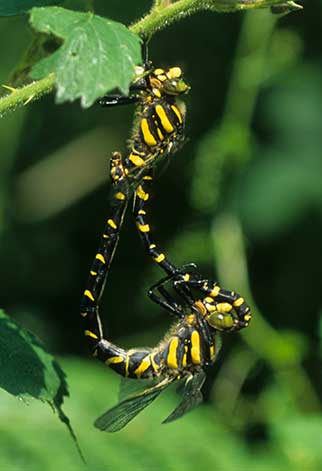Golden-ringed Dragonfly (Cordulegaster boltonii)
When: Early June to late August
How many: Rarely abundant but fairly widespread

mating in Pondhead
Inclosure
Monsters of the waterways, Golden-ringed Dragonflies are large, conspicuous creatures - their wingspan is a mighty 10 centimetres, whilst length is around 8 centimetres.
They are also aptly named, for colouration and patterning in both sexes comprises golden-yellow bands superimposed onto a black background. Large green eyes serve only to enhance an appearance of menace.
On the wing from early June until late August, with peak activity usually in July, Golden-ringed Dragonflies can often be seen well away from water, most frequently on heathland or cruising along woodland rides. However, streams and rivers, both slow and faster flowing, and usually in open situations rather than in woodland, provide particularly favoured habitat.
Strong, purposeful, direct but highly manoeuvrable flight is often accompanied by quite loud rustling sounds - made when their wings brush against each other or against adjacent vegetation - as these notable insects repeatedly fly backwards and forwards along frequently used hunting 'beats'. Battles between competing insects are sometimes witnessed, whilst prey items include a wide range of smaller insects, including other dragonflies and damselflies.
Golden-ringed Dragonflies occur widely in the New Forest, but territorial habits ensure that they are rarely seen in large numbers.
References:
A Guide to the Dragonflies of Great Britain: Dan Powell
Dragonflies and Damselflies of Britain and Northern Europe: Bob Gibbons
The Dragonflies of Hampshire - John Taverner, Steve Cham, Alan Hold, et al
More links
Other related links
Search this site

Sadly, 58 animals were killed - 35 ponies, 13 cows, 8 donkeys and 2 sheep, whilst a further 32 were injured - 3 pigs, 9 donkeys, 11 cows and 9 ponies.
(Forty-three accidents occurred in daylight, 15 at twilight and 101 in the dark. Twenty-seven accidents were not reported by the driver involved).
Here's just one horrific example - Three donkeys killed in collision with van at notorious New Forest blackspot (Advertiser and Times)

